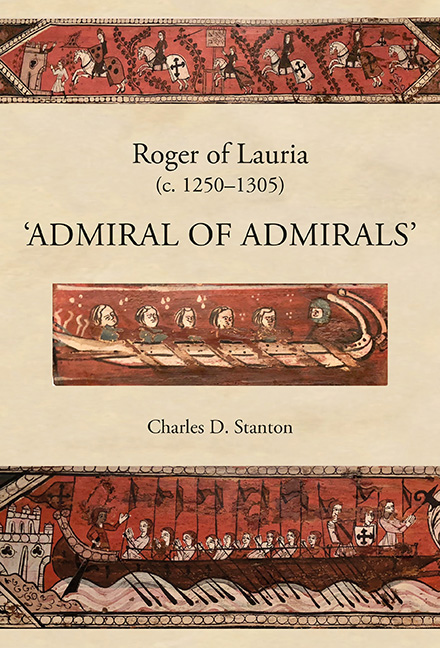Book contents
- Frontmatter
- Dedication
- Contents
- List of Illustrations
- Prologue
- 1 Battle of Benevento (26 February 1266)
- 2 A Calabrian Exile in the Court of Aragon (1262–1282)
- 3 Battle of Tagliacozzo (23 August 1268)
- 4 Aragonese Expansion (1229–1282)
- 5 Angevin Consolidation and Aggrandizement (1268–1282)
- 6 Revolt of the Vespers (30 March 1282)
- 7 Aragonese Intervention (August–October 1282)
- 8 Stalemate (November 1282–March 1283)
- 9 Admiral of Aragon (20 April 1283)
- 10 The Opposing Fleets (1282–1302)
- 11 Battle of Malta (8 June 1283)
- 12 Anjou's Dreams of Empire Dashed (June–November 1284)
- 13 France's Crusade Against Aragon (May–November 1285)
- 14 Battle of the Counts (23 June 1287)
- 15 Truces and Treaties (June 1287–November 1291)
- 16 Raid on Romania (Summer 1292)
- 17 Switching Sides (December 1293–April 1297)
- 18 Aragon's Invasion of Sicily at Anjou's Bidding (1298/1299)
- 19 Lauria's Last Great Campaign (Summer 1299–Spring 1300)
- 20 Endgame (Spring 1301–Summer 1302)
- Epilogue
- Bibliography
- Index
12 - Anjou's Dreams of Empire Dashed (June–November 1284)
Published online by Cambridge University Press: 24 October 2019
- Frontmatter
- Dedication
- Contents
- List of Illustrations
- Prologue
- 1 Battle of Benevento (26 February 1266)
- 2 A Calabrian Exile in the Court of Aragon (1262–1282)
- 3 Battle of Tagliacozzo (23 August 1268)
- 4 Aragonese Expansion (1229–1282)
- 5 Angevin Consolidation and Aggrandizement (1268–1282)
- 6 Revolt of the Vespers (30 March 1282)
- 7 Aragonese Intervention (August–October 1282)
- 8 Stalemate (November 1282–March 1283)
- 9 Admiral of Aragon (20 April 1283)
- 10 The Opposing Fleets (1282–1302)
- 11 Battle of Malta (8 June 1283)
- 12 Anjou's Dreams of Empire Dashed (June–November 1284)
- 13 France's Crusade Against Aragon (May–November 1285)
- 14 Battle of the Counts (23 June 1287)
- 15 Truces and Treaties (June 1287–November 1291)
- 16 Raid on Romania (Summer 1292)
- 17 Switching Sides (December 1293–April 1297)
- 18 Aragon's Invasion of Sicily at Anjou's Bidding (1298/1299)
- 19 Lauria's Last Great Campaign (Summer 1299–Spring 1300)
- 20 Endgame (Spring 1301–Summer 1302)
- Epilogue
- Bibliography
- Index
Summary
THE ANGEVIN ANSWER to the devastating defeat at Malta was to assemble overwhelming force. Within weeks of losing the Provençal fleet, Charles of Anjou and his son Charles of Salerno embarked upon an aggressive campaign to construct an armada so massive that it would swamp its Aragonese counterpart by its sheer size. They began by cajoling Pope Martin into contributing ecclesiastical tithes earmarked for crusades to the Holy Land. Loans were acquired from the great banking families of Florence and Lucca; the merchants of Tuscany were tapped as well; and even Edward I of England was convinced to lend some funds to the cause. And, of course, taxes were collected ruthlessly throughout Provence and the Regno to finance the effort. Prince Charles even went so far as to garnish his father's crown jewels for cash, but the king derailed the transaction, offering up his silver tableware instead. It is estimated that the two Angevin royals raised around 335,000 ounces of gold between September 1283 and June 1284 alone.
These funds were used to underwrite a vigorous shipbuilding programme in Angevin arsenals from Provence to Apulia. At the same time, the great maritime cities of Genoa, Pisa, Venice and Ancona were approached with lucrative offers to lease fully crewed combat vessels. The House of Anjou petitioned Pisa for fifty galleys, for instance, and Genoa for forty. Unfortunately for Charles and son, both the Genoese and the Pisans demurred because they were, once again, distracted by open hostilities with one another, while Venice (and probably also Ancona) chose to adhere to a policy of strict neutrality concerning the conflict. Nonetheless, the Angevins were able to generate more than enough warships on their own. Upon his return to Provence after the abortive duel at Bordeaux, Charles of Anjou reportedly oversaw the production of thirty-four to thirty-eight galleys at his shipyard in Marseilles, while his son was able to equip another thirty at Naples. To these numbers, Brindisi added as many as forty. The Angevin Registers also listed around thirty galleys from Gaeta and another sixty-eight gathered from various ports in Apulia and the Abruzzi. The latter two provinces also produced at least fifty taride. Dozens of other transport ships were collected from Calabria, the Basilicata, the Terra di Lavoro and the Capitanata. Altogether, Angevin naval assets must have exceeded 200 by the late spring of 1284.
- Type
- Chapter
- Information
- Roger of Lauria (c.1250–1305)‘Admiral of Admirals’, pp. 160 - 176Publisher: Boydell & BrewerPrint publication year: 2019

